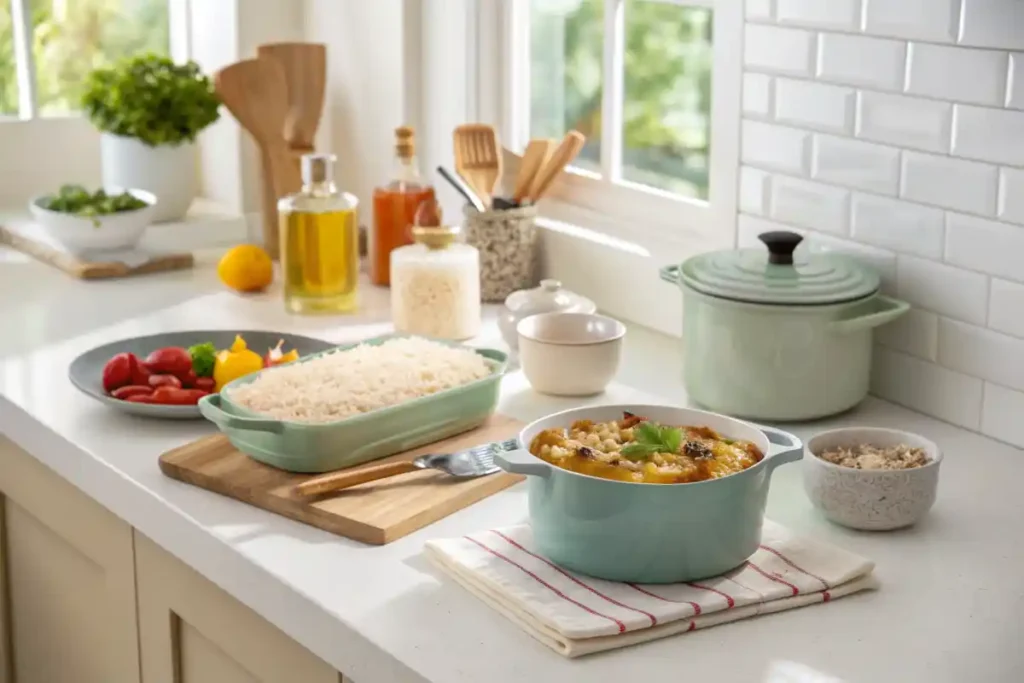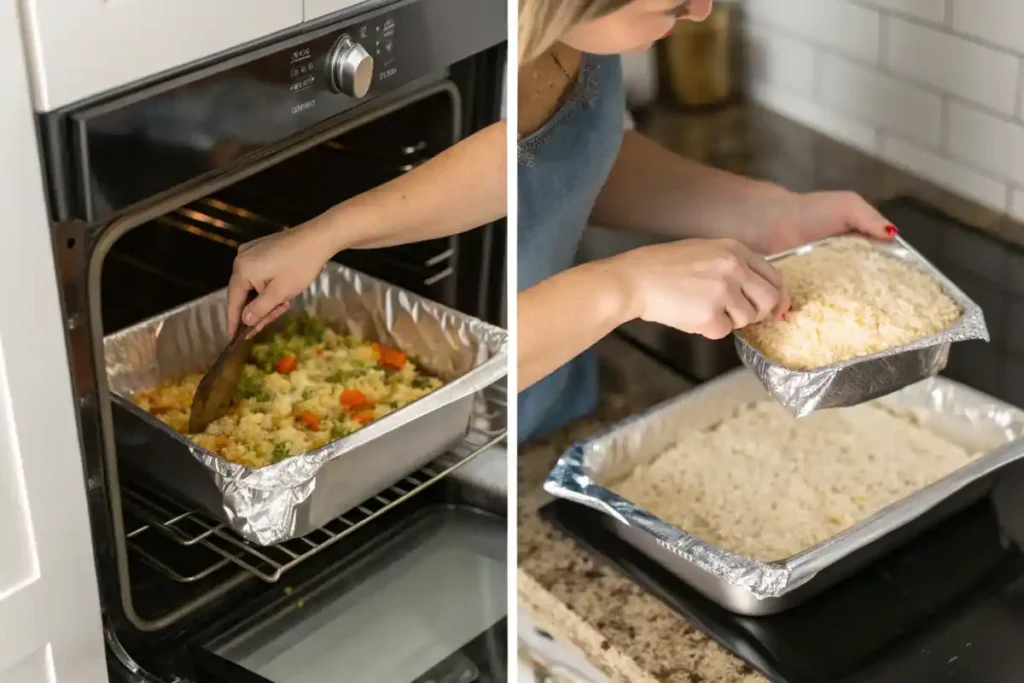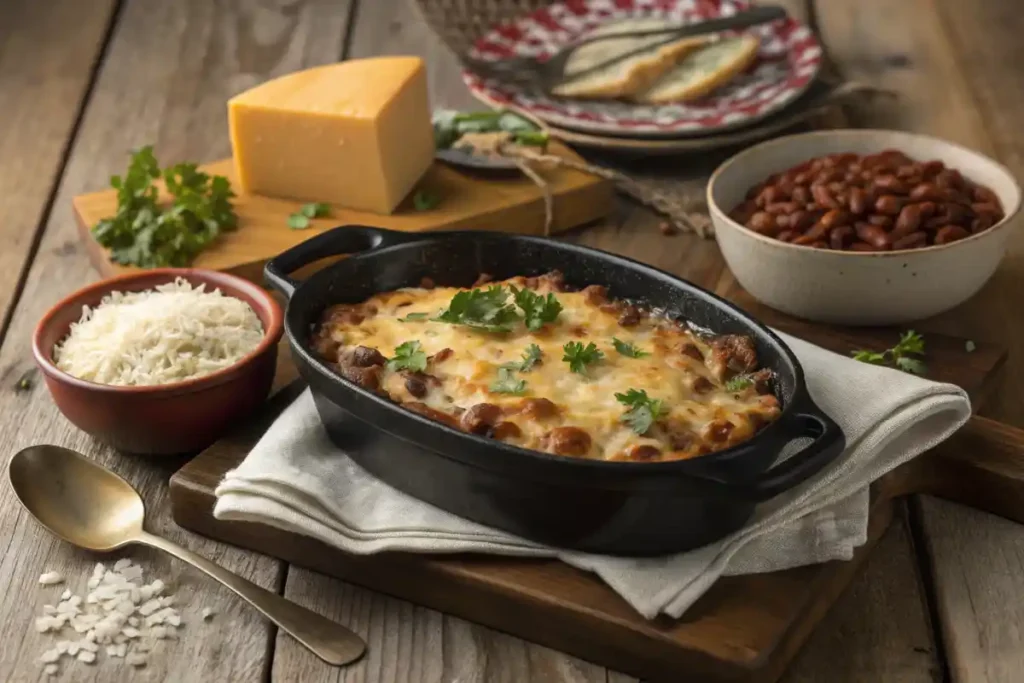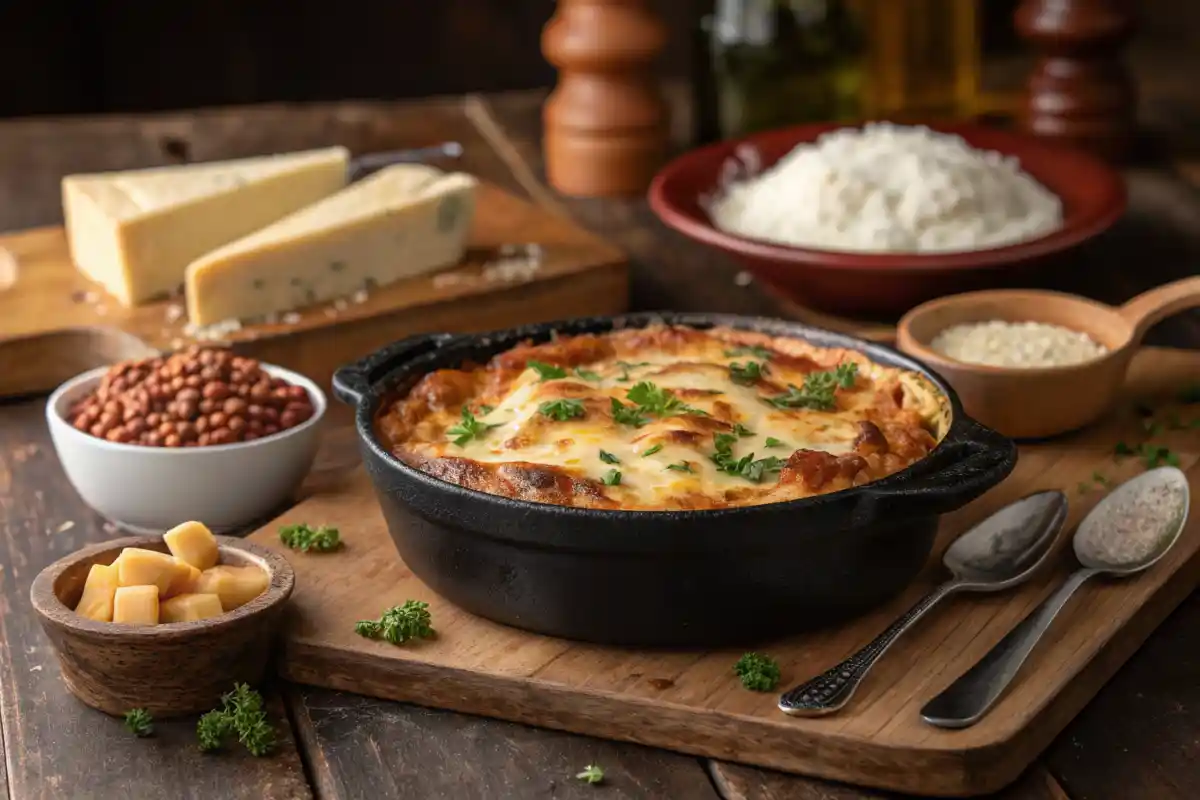Do You Cook Rice Before Putting It in a Casserole?
When preparing a casserole, many wonder, Do you cook rice before putting it in a casserole? The answer depends on the recipe you’re following. Some casseroles require pre-cooked rice to ensure even cooking and a soft texture, while others are designed for raw rice that cooks in the dish’s liquid. Understanding when and why to cook the rice first can make a significant difference in your casserole’s final outcome.
In this article, we’ll explore the benefits of each method, share tips for perfect casseroles, and help you decide which approach works best for your recipe. Let’s dive in and learn how to master rice preparation for casseroles!
Table of contents
- Do You Cook Rice Before Putting It in a Casserole?
- When to Cook Rice Before Adding It to a Casserole
- Practical Tips for Preparing Rice for Casseroles
- Common Mistakes to Avoid When Using Rice in Casseroles
- Secrets to Perfectly Flavored Rice in Casseroles
- How to Prevent Common Casserole Rice Problems
- Creative Ways to Elevate Your Casserole with Rice
- Pre-Cooked vs. Raw Rice: Which Works Best for Casseroles?
- Conclusion: Perfecting Rice Preparation for Casseroles
- Frequently Asked Questions About Rice and Casseroles


When to Cook Rice Before Adding It to a Casserole
Recipes That Require Pre-Cooked Rice
Many casseroles call for pre-cooked rice, especially when the recipe includes quick cooking times or when the casserole doesn’t have enough liquid to cook raw rice. Using cooked rice also helps maintain consistency, as it ensures the rice is already tender before baking.
For example, dishes like chicken and rice casserole or broccoli cheese casserole often use pre-cooked rice to prevent undercooked grains. This method also shortens the total cooking time, which is ideal for busy weeknights.
When You Can Use Raw Rice in a Casserole
Some casseroles are designed for raw rice to cook along with the dish. These recipes usually include enough liquid—like broth, water, or tomato sauce—to cook the rice during baking. Using raw rice can save you a step and allow the grains to absorb the dish’s flavors more thoroughly.
This method works best for recipes with longer cooking times, as raw rice needs enough time and liquid to become tender. For instance, baked Mexican rice casseroles or one-pot chicken and rice dishes often rely on this technique.

Do You Cook Rice Before Putting It in a Casserole? Key Considerations
Why the Cooking Method Matters
When deciding whether to cook rice before adding it to a casserole, consider the recipe and the type of rice being used. Some recipes benefit from pre-cooked rice because it reduces baking time and ensures even cooking. Others rely on raw rice, which absorbs the casserole’s liquid and flavors as it bakes.
For instance, pre-cooked rice is ideal for casseroles with shorter baking times. On the other hand, raw rice works better in recipes that include plenty of liquid and longer cooking durations. By choosing the right method, you can avoid common problems like undercooked or mushy rice.
How Liquid Impacts Rice in Casseroles
The liquid ratio plays a crucial role in determining whether to cook rice first. Recipes with raw rice require enough liquid to hydrate the grains during baking. Typically, 1 ½ to 2 cups of liquid per cup of raw rice ensures proper cooking. In contrast, pre-cooked rice only needs enough liquid to maintain moisture in the dish.
For example, casseroles with sauces or broths often allow raw rice to cook perfectly. However, drier recipes benefit from pre-cooked rice to avoid crunchiness. Adjusting the liquid ensures the rice complements the casserole’s texture and flavor.
Balancing Flavors with Rice
Whether using pre-cooked or raw rice, balancing flavors is essential. Pre-cooking rice in seasoned broth enhances its taste, while raw rice absorbs the flavors of the surrounding ingredients. This absorption creates a cohesive and flavorful dish that satisfies every bite.
Seasoning the rice and other casserole components ensures a balanced and delicious result. By understanding how rice interacts with liquids and flavors, you can create casseroles that impress every time.

Practical Tips for Preparing Rice for Casseroles
How to Pre-Cook Rice for a Casserole
Cooking rice before adding it to a casserole is simple and helps prevent undercooked grains. Start by rinsing the rice to remove excess starch. Next, boil it in water or broth until it is slightly undercooked—this way, it doesn’t become mushy during baking. Finally, drain the rice and let it cool before mixing it into your casserole.
By following these steps, your rice will stay tender and absorb flavors during baking. For an added twist, cook the rice in chicken or vegetable stock instead of water to boost the taste.
Using Raw Rice in a Casserole
If your recipe calls for raw rice, ensure there is enough liquid in the dish. Use one and a half to two cups of liquid for every cup of uncooked rice. Combine the rice with other ingredients and stir well so everything cooks evenly. Cover the casserole with foil for the first half of baking to trap steam, then remove it to create a golden top.
This method saves time and creates a flavorful, one-dish meal. However, check the rice as it bakes to ensure it is fully cooked before serving.
Common Mistakes to Avoid When Using Rice in Casseroles
Adding Too Much or Too Little Liquid
The most common mistake when preparing rice for casseroles is getting the liquid ratio wrong. Using too much liquid can make the dish soggy, while too little leaves the rice undercooked. For pre-cooked rice, only add enough liquid to keep the casserole moist. When using raw rice, stick to the guideline of 1 ½ to 2 cups of liquid per cup of rice.
To ensure accuracy, measure both the rice and liquid carefully. If you’re experimenting with additional ingredients like vegetables or sauces, adjust the liquid accordingly.
Skipping the Rinsing Step
Rinsing rice may seem unnecessary, but it removes excess starch that can make the dish sticky. Hold the rice under cold running water in a fine-mesh sieve until the water runs clear. This simple step helps create a fluffy texture that pairs perfectly with other casserole ingredients.
Overcooking the Rice Before Baking
Pre-cooked rice that is fully cooked before baking can turn mushy. Instead, cook the rice until it’s slightly firm (al dente). It will continue to absorb liquid during baking, reaching the perfect texture when the casserole is done.
Ignoring Layering Techniques
The order in which you layer ingredients in your casserole matters. When using raw rice, place it at the bottom of the dish to ensure it absorbs liquid effectively. If pre-cooked rice is used, mix it with other ingredients evenly to avoid dry spots.
Secrets to Perfectly Flavored Rice in Casseroles
Infuse Flavor While Cooking the Rice
Don’t rely on the casserole alone to flavor your rice. Instead, cook it in broth or stock to add depth from the start. Use chicken, beef, or vegetable stock, depending on your recipe. Adding a few garlic cloves, bay leaves, or a splash of olive oil while the rice cooks can enhance its flavor.
“Cooking rice in broth instead of plain water added a rich, savory taste to my casserole—it made all the difference!”
Season Every Layer of the Casserole
Many people make the mistake of only seasoning the top layer of a casserole. However, seasoning each layer ensures the flavors are consistent throughout the dish. Mix spices, herbs, or even a pinch of salt into the rice before layering it with the other ingredients.
“I seasoned the rice, chicken, and vegetables separately, and the casserole tasted incredible in every bite!”
Use Aromatic Ingredients for a Boost
To make your rice stand out, include aromatic ingredients like sautéed onions, garlic, or shallots. You can also mix in fresh herbs like parsley or cilantro just before baking. These small additions create a more complex and delicious flavor profile.
“Sautéing onions and garlic before mixing them with rice gave my casserole a warm, comforting aroma.”
How to Prevent Common Casserole Rice Problems
Avoid Dry Rice by Adjusting Liquid Ratios
Dry rice in casseroles is often caused by insufficient liquid. Always measure carefully. Use 1 ½ to 2 cups of liquid for every cup of raw rice. If your casserole includes vegetables or meat that release water during cooking, slightly reduce the liquid to avoid a soupy texture.
“I started measuring the broth and added just enough for the rice—it worked perfectly!”
Stop Mushy Rice with Precise Cooking Times
Mushy rice can ruin an otherwise great casserole. To avoid this, slightly undercook the rice if pre-cooking it before adding it to the casserole. For raw rice, make sure your baking time matches the rice’s cooking requirements. Keep an eye on the dish as it bakes to avoid overcooking.
“Cooking the rice al dente before baking kept it perfectly tender, not mushy.”
Prevent Uneven Cooking by Stirring Ingredients
When raw rice and other ingredients aren’t mixed properly, you may end up with unevenly cooked rice. Stir all components thoroughly before baking. Ensure the rice is evenly distributed to absorb liquid consistently throughout the casserole.
“I mixed everything well before baking, and the rice cooked evenly with no crunchy bits!”
Creative Ways to Elevate Your Casserole with Rice
Add Vegetables for Flavor and Nutrition
Incorporate a variety of vegetables into your casserole to enhance both flavor and nutrition. Options like bell peppers, mushrooms, and zucchini pair well with rice and add a pop of color to your dish. Roast the vegetables beforehand to deepen their flavors and create a caramelized touch.
“Adding roasted vegetables brought a smoky, rich flavor to my casserole—it was a hit!”
Experiment with Different Types of Rice
Don’t limit yourself to white rice! Brown rice adds a nutty flavor and extra fiber, while wild rice brings a unique texture and earthy taste. Basmati rice offers a fragrant aroma that can elevate even the simplest casseroles. Choose the type of rice that complements your other ingredients best.
“Switching to wild rice made my casserole stand out with a bold, earthy flavor.”
Use Herbs and Spices for a Gourmet Touch
Fresh herbs like basil, thyme, or dill can take your casserole to the next level. Stir these into the rice before baking for even distribution. Spices such as turmeric, paprika, or cumin can add warmth and complexity to the dish. Season generously, but balance the flavors carefully to avoid overpowering the other ingredients.
“I added turmeric and thyme to the rice, and it gave the casserole a vibrant look and taste.”
Pre-Cooked vs. Raw Rice: Which Works Best for Casseroles?
When Pre-Cooked Rice is the Right Choice
Pre-cooked rice is often preferred in casseroles with shorter baking times or minimal liquid. Since the rice is already tender, it blends seamlessly with the other ingredients. For example, chicken and broccoli casseroles frequently use pre-cooked rice to achieve a cohesive texture.
Using pre-cooked rice also saves time during preparation. If you’re working with leftovers or batch-cooked rice, this option simplifies the process. Pre-cooked rice prevents the risk of undercooked grains, ensuring your casserole is ready to enjoy right out of the oven.
Why Raw Rice Might Be Better for Some Casseroles
In contrast, raw rice works well for casseroles that bake for an extended period and contain plenty of liquid. The rice absorbs the broth or sauce as it cooks, creating a flavorful base for the dish. Recipes like baked Mexican rice casseroles or one-pot chicken and rice thrive on this method.
Using raw rice also eliminates the need for pre-cooking, reducing cleanup and making the preparation more efficient. However, ensuring the liquid ratio is accurate is crucial to avoid undercooked grains or overly dry textures.
How to Decide Which Rice Method to Use
The decision between pre-cooked and raw rice ultimately depends on your casserole recipe. Recipes that emphasize quick preparation benefit from pre-cooked rice, while those with rich sauces and longer baking times make excellent use of raw rice. By aligning your choice with the recipe’s requirements, you can ensure a delicious outcome.

Conclusion: Perfecting Rice Preparation for Casseroles
Preparing rice for casseroles doesn’t have to be a challenge. Whether you choose pre-cooked rice for convenience or raw rice for flavor absorption, understanding the right techniques can elevate your dish. By managing liquid ratios, cooking times, and seasoning layers, you can ensure your rice complements the casserole perfectly.
For detailed recipes and tips, explore Allrecipes’ Rice Casserole Collection, which offers a variety of ideas for every occasion. Additionally, check out QuickTasty’s Guide to Perfect Casserole Preparation for step-by-step advice tailored to home cooks.
By applying these strategies and exploring new recipes, you’ll confidently answer the question: “Do you cook rice before putting it in a casserole?” and create meals your family will love. Enjoy cooking and experimenting with your next casserole creation!
Frequently Asked Questions About Rice and Casseroles
No, it depends on the recipe. Some casseroles require pre-cooked rice for quicker cooking times, while others include enough liquid to cook raw rice during baking.
Using raw rice without sufficient liquid can result in undercooked grains. Ensure you add 1 ½ to 2 cups of liquid for every cup of uncooked rice to avoid this issue.
Yes, instant rice is a convenient option for casseroles. However, since it cooks quickly, you should reduce the baking time and adjust the liquid to avoid a mushy texture.
Pre-cooked rice ensures consistent texture and reduces baking time. It’s ideal for casseroles with shorter cooking durations or minimal liquid.
To pre-cook rice, rinse it, cook it in water or broth until slightly undercooked, and drain it. This method prevents the rice from becoming mushy during baking.
Absolutely! Flavored rice, such as Spanish rice or pilaf, can enhance the casserole’s overall taste. Ensure it complements the other ingredients in the recipe.
Raw rice typically takes 40–60 minutes to cook in a casserole, depending on the type of rice and the liquid ratio. Covering the casserole with foil helps trap steam for even cooking.
Long-grain rice like jasmine or basmati works well for fluffy results. For a creamier texture, try arborio or short-grain rice.

